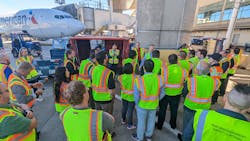The Intelligent Airport Apron Becomes Reality
Digitized apron operations are ready to take a big leap forward in North America as the technology has proven itself effective in operation at Dallas Fort Worth International Airport (DFW).
The Intelligent Apron trial was conducted by the AAAE Airport Consortium on Consumer Trust (ACT) from September to November at Gate 9A DFW. The gate is used exclusively by American Airlines, providing a feasible test location between the parties. Stakeholders included ADB Safegate, Synaptic Aviation, DFW and American Airlines.
The connected gate concept is designed to reduce delays by ensuring ground crews are ready when arriving aircraft are nearing the airport. It provides information to stakeholders prior to the aircraft’s arrival at the gate and real-time information on how soon they must prepare the apron for arrival.
“This initiative has huge value in the current airport conditions because it can leverage existing assets,” Carlye Airport Group Chief Strategy Officer Ginger Evans said. “It makes better use of those existing assets and it supports a more efficient and safe ramp operation with fewer employees.”
ADB Safegate deployed a Safedock FleX unit on A9 as well as a shadow SAM system in AWS. This allowed for collection of real-time operational performance data without affecting operational systems other than overnight replacement of the physical docking system.
The unit offers a color display and separate scanning unit with wider scanning area. The display itself is more brilliant and multicolored, so it can be read from wide angles and from longer distances with much more granular detail. It utilizes a laser with a wider scanning angle that scans at rapid speeds to provide pilots are clearer view of what’s occurring right in front of the aircraft.
This creates high visibility of information for ground crews and pilots, while artificial intelligence captures operational timestamps to build benchmarks to turn around aircraft. Video AI is connected to the passenger boarding bridge to monitor parking and movement of the unit to ensure safety and time to connect to an aircraft. It also measures ground power unit (GPU) and pre-conditioned air (PCA) connections to the aircraft to monitor the time and length of connection by ground handlers.
“You’ve got, the airlines stakeholders, the ground handler stakeholders, the airports, the FAA and everybody else who operates out there are stakeholders,” Tom Duffy, Group Business Development Advisor for ADB Safegate said. “The main thing is being able to gather information in real time and connect those pieces of information together so they all get the flow of events and what’s happening on the apron.”
During the trial and demonstration, the predictive functions of the Video AI were used to determine an on-time departure based on detected activities. The real-time view of the gate analytics presented a predicted departure time calculated by an AI model trained from several thousand departures.
The DFW trial brought together computer analytics, artificial intelligence and computer vision and worked all three technologies together to build a complete picture of what’s taking place on the apron.
Juan Gomez, CEO of Synaptic Aviation, said computer vision allows the computer to see and identify certain elements on the apron. Artificial intelligence teaches the computer vision what it’s seeing and continue learning as operations proceed daily.
“Think of eyes and the brain. The eye is just a lens to the brain and the brain is interpreting what it’s seeing,” he said.
The DFW trial brings previously untracked elements into reality for airport operations. The technology allows operations staff to track how long it takes for a passenger boarding bridge to connect to an aircraft at the gate. The data allows staff to see a baseline average on how long it takes for a bridge to connect to an aircraft and if there’s a spike in connection times, it could highlight either a mechanical failure or improperly trained employee.
"There’s a lot of noise around the gate and on the apron,” Gomez said. “By bringing these datapoints together, we can take away the noise and reflect how things are actually operating at the gate.”
Tom Duffy, Group Business Development Advisor for ADB Safegate, said operations at Gate A9 were good when the trial began, but they were able to determine specific operations data with the new technology and discover improvements. The system identifies and tracks 17 different ground service activities and logs timestamps in real-time.
Pre-arrival FOD walks that are typically not tracked automatically are now logged by the IA system and failure to comply events are reported/logged automatically.
Passenger boarding bridge extension delays went down from 9.7% at the beginning of the trial to 3.3% in November.
The system records an arrival hold when an aircraft is stationary short of the gate for at least 30 seconds. Arrival hold events are now consistently detected and tracked for VDGS calibration and possible triggering of just-in-time docking. The detailed and consistent data capture makes possible the identification of operational trends. For example, arrival holds at A9 occur mostly on Thursdays and Fridays between 6 p.m. and 7 p.m.
Average hold time short of gate went down to 1.5 minutes from 5.2 minutes on average at the beginning of the trial. The percentage of holds relative to arrivals reduced over time as well.
“Most everything we did in this trial has been done somewhere else, just not in its entirety,” Duffy said. “There are plenty of airports that use a VDGS. There are plenty of airports that connected to GPUs and pre-condition air. There's a lot of airports that connected to boarding bridges, but there isn't many airports that connect all the systems and that's, that's the real big difference here.”
According to the study, the average turnaround time of aircraft at A9 was 86 minutes. Twenty-seven percent of all flights arrived at the gate at least 15 minutes earlier than scheduled.
During the trial, it took an average 14.6 minutes for the first bag to be unloaded after the aircraft parked. In relation to this, the average debarkation time for all passengers was 17 minutes.
The artificial intelligence and computer vision systems were trained to watch 16 activities related to the turnaround of aircraft. The system continuously learned operations to adjust for changes in operations and changes around the apron.
Having proven the ability of these technologies to work together on the apron, it paves the way for larger automation and efficiency gains on the airfield. It provides airports, ground handlers and airlines a clear image of operations on the ramp and accurate timeframes for times to perform tasks.
And airports can make smaller technology investments on the ramp to see some of the gains from the DFW trial, especially as digitization becomes imperative for the future of airport operations.
“You don’t have to do all of it to get some efficiencies,” Evans said. “Just being able to get planes off of a hold path and into a gate is job one and you can do that with very minimal investment.”
About the Author
Joe Petrie
Editor & Chief
Joe Petrie is the Editorial Director for the Endeavor Aviation Group.
Joe has spent the past 20 years writing about the most cutting-edge topics related to transportation and policy in a variety of sectors with an emphasis on transportation issues for the past 15 years.
Contact: Joe Petrie
Editor & Chief | Airport Business
+1-920-568-8399
>> To download the AviationPros media kits, visit: Marketing Resource Center
>>Check out our aviation magazines: Ground Support Worldwide | Airport Business | Aircraft Maintenance Technology

